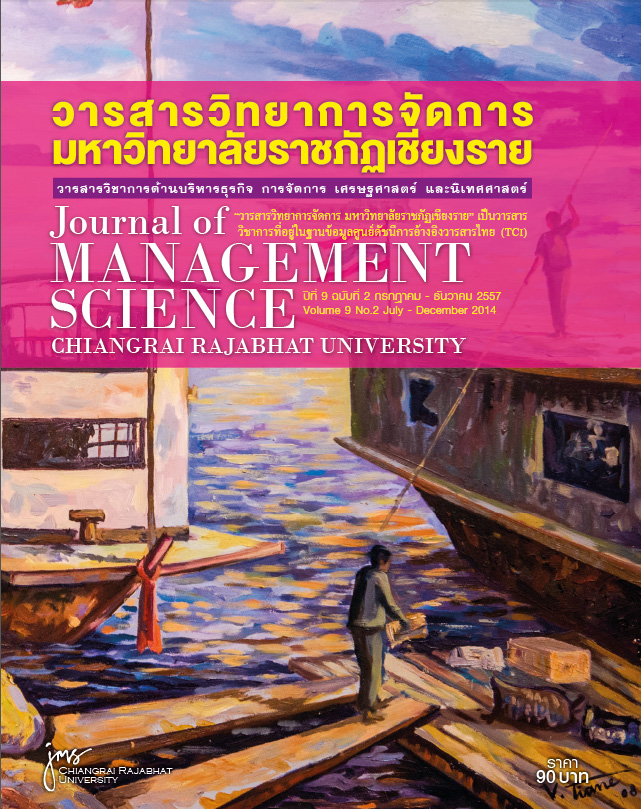ศึกษารูปแบบการดำเนินชีวิตของกลุ่มผู้ฟังสถานีวิทยุชุมชน : กรณีศึกษา วิทยุชุมชนเชิงพาณิชย์ที่ใช้การสื่อสารการตลาดผ่านช่องทางสื่อใหม่
Main Article Content
บทคัดย่อ
การศึกษาครั้งนี้ มีวัตถุประสงค์เพื่อศึกษารูปแบบการดำเนินชีวิตของกลุ่มผู้ฟัง รูปแบบการสื่อสารการตลาดผ่านช่องทางสื่อใหม่ของสถานีวิทยุชุมชนเชิงพาณิชย์ และศึกษาความเกี่ยวข้องหรือเชื่อมโยงของรูปแบบการดำเนินชีวิตและการสื่อสารการตลาดผ่านช่องทางสื่อใหม่ โดยผู้ศึกษาเก็บรวบรวมข้อมูลด้วยการสนทนากลุ่มของกลุ่มผู้ฟังวัยทำงาน และนักเรียน การสัมภาษณ์เชิงลึกของกลุ่มเจ้าของสถานีของวิทยุชุมชนเชิงพาณิชย์ที่ใช้การสื่อสารการตลาดผ่านช่องทางสื่อใหม่ เครื่องมือที่ใช้ในการศึกษา คือ แบบสนทนากลุ่มและแบบสัมภาษณ์เชิงลึก ผลการศึกษาด้านกิจกรรม ประกอบไปด้วย กิจกรรมหลัก คือการเรียนและการทำงาน ส่วนใหญ่ในวัยทำงานประกอบธุรกิจส่วนตัว กิจกรรมที่เป็นการเรียนเน้นการค้นคว้าทางสื่ออินเตอร์เน็ตเป็นหลัก กิจกรรมยามว่าง คือ กิจกรรมที่ต้องใช้เวลาอยู่กับตัวเอง และกิจกรรมทางสังคมพบว่า ผู้ให้สัมภาษณ์ไม่เข้าร่วมกิจกรรมทางสังคม ผลการศึกษาด้านความสนใจ พบว่า ด้านครอบครัว สภาพครอบครัวเป็นครอบครัวเดี่ยว ด้านงานเป็นงานประจำที่มีเวลาเข้าออกที่แน่นอน ด้านอาหารนิยมทานอาหารที่บ้าน สื่อที่นิยมใช้มากที่สุด คือ สื่อใหม่ (เฟสบุ๊ค, ไลน์, เว็บไซด์) และสรุปความสำเร็จของกลุ่มตัวอย่างมุ่งที่เรื่องงานเป็นหลัก เจ้าของสถานีมีการใช้สื่อสารการตลาด 5 ประเภท คือ การโฆษณา การส่งเสริมการขาย การประชาสัมพันธ์ การสนับสนุนทางการตลาดและกิจกรรมทางการตลาด การโฆษณา โดยโฆษณาผ่านสื่อเฟสบุ๊ค สื่อเว็บไซด์และสื่อสิ่งพิมพ์ เพื่อสร้างให้เกิดการจดจำและการกระตุ้นให้ผู้ฟังเกิดการตัดสินใจเลือกฟังสถานีวิทยุ การส่งเสริมการขาย โดยส่วนใหญ่จะเน้นกิจกรรมที่สร้างการมีส่วนร่วมระหว่างคนฟังกับสถานีวิทยุผ่านทางเว็บไซด์และเฟสบุ๊คของผู้ฟังและกระตุ้นให้คนฟังสถานีเพิ่มมากขึ้น การประชาสัมพันธ์ เน้นข่าวสารต่าง ๆเกี่ยวกับการบำเพ็ญสาธารณประโยชน์เพื่อสังคม โดยจะประชาสัมพันธ์ผ่านเว็บไซด์ เฟสบุ๊คของสถานีและหนังสือพิมพ์ เพื่อสร้างภาพลักษณ์ที่ดีให้กับสถานีวิทยุ การสนับสนุนทางการตลาด เน้นกิจกรรมการโปรโมทคลื่น รูปแบบของรายการ นักจัดรายการและเจ้าของสถานี โดยทางสถานีจะส่งนักจัดรายการไปช่วยเป็นพิธีกร การสนับสนุนเงินรางวัลและสิ่งของให้กับบริษัท ห้างร้าน และหน่วยงานต่างๆ กิจกรรมทางการตลาด เน้นการเปิดตัวสถานีให้เป็นที่รู้จักแก่คนหมู่มาก สร้างการรับรู้ สร้างความสนใจให้กับกลุ่มเป้าหมาย
Article Details
ทัศนะและข้อคิดเห็นของบทความที่ปรากฏในวารสารฉบับนี้เป็นของผู้เขียนแต่ละท่าน ไม่ถือว่าเป็นทัศนะและความรับผิดชอบของกองบรรณาธิการ
เอกสารอ้างอิง
oct_dec_1 /pdf/aw021.pdf. ธิดาพร ชนะชัย. 2550. New Media New Challenges : Marketing Communication Through New Media. (Online) Available: http://www.commart.hcu.ac.th/images/academic_article/nok/new_media _newchal lenges.pdf. ค้นเมื่อวันที่ 10 กันยายน 2555. ธีรพันธ์โล่ห์ทองคา. (2544). กลยุทธ์สื่อสารการตลาดแบบครบวงจร.กรุงเทพฯ: อินโฟเมอร์เดเชียลมาร์ก._______. (2551). Inside IMC เจาะลึกถึงแก่นไอเอ็มซี. กรุงเทพฯ:อินโฟเมอร์เดเชียลมาร์ก. นนทกร ศาลิคุปต. ความสัมพันธ์ระหว่างบุคลิกภาพตราสินค้ากับบุคลิกภาพผู้บริโภคและทัศนคติของผู้บริโภค. ประทัย พิริยะสุรวงศ์. (2555). ทัศนคติและพฤติกรรมการสื่อสารผ่านเครือข่ายสังคมออนไลน์ของนักศึกษานิเทศก์ศาสตร์ ชั้นปี ที่ 1. มหาวิทยาลัยราชภัฏเชียงราย. ประภาภร ดลกิจ. (2544). การวิเคราะห์การจัดการรายการวิทยุชุมชน "สร้างสรรค์จันทบุรี". กรุงเทพฯ:จุฬาลงกรณ์มหาวิทยาลัย. ปิยะพร เขตบรรพต. (2553). พฤติกรรมการรับการสื่อสารการตลาดผ่านสื่อใหม่ของผู้บริโภคในอำเภอเมืองเชียงใหม่. (การศึกษาอิสระบริหารธุรกิจมหาบัณฑิต).
มหาวิทยาลัยเชียงใหม่.สื่อค้นจากฐานข้อมูลงานวิจัย ThaiLis Digital Collection. มหาวิทยาลัยสุโขทัยธรรมาธิราช. (2556). ตำราอบรมหลักสูตรผู้ประกาศในกิจการกระจาย เสียงและกิจการโทรทัศน์ ระดับต้น.กรุงเทพ. ส เจริญ การพิมพ์จำกัด.
เมธาสิทธิ์ โลกุตรพล. (2555). สื่อใหม่ : การมาถึงของศูนย์กลางผู้บริโภค / Consumer Centric. สืบค้นเมื่อ 20 มิถุนายน 2555, จาก http://cujrnewmedia.wordpress.com/2012/02/20/. วรางคณา มาตา. (2547) รูปแบบการดำเนินชีวิตของผู้ชายวัยทำงาน ในอำเภอเมือง จังหวัดเชียงใหม่. (การศึกษาอิสระบริหารธุรกิจมหาบัณฑิต). มหาวิทยาลัยเชียงใหม่.สื่อค้นจากฐานข้อมูลงานวิจัย ThaiLis Digital Collection. สื่อโฆษณายุคใหม่. (2549). (online). Available: https://www.l3nr.org/posts/200861. ค้นเมื่อ21 สิงหาคม 2554. เสรี วงษ์มณฑา. (2548). การวิเคราะห์พฤติกรรมผู้บริโภค. กรุงเทพมหานคร : ธีระฟิล์มและไซเท็กซ์. Casta and McCrae. (1992). The NEO-Pl Personality Inventory. Odessa, FL : Psychological Assessment Resources. Joseph T. Plummer. (1974). Joumal of Marketing. The concept and Application of Life-styleSegmentation. 1, 3(January):34. New media. (2555). (Online). Available: http://www.webnox.com/viral_marketing/new_medi. สืบค้นเมื่อ27กรกฎาคม 2555. New media. (2555). (Online). Available: http://cujrnewmedia.wordpress.com /2012. สืบค้นเมื่อ10กรกฎาคม 2557. New media marketing. (2555). (Online). Available: http://en.wikipedia. org/wiki/New_media_marketing. สืบค้นเมื่อ27กรกฎาคม 2555. Plummer, E.S.,&Albert,S. G. (1995). Foot care assessment in patients with diabetes: A screening algorithm for patient education and referral. Diabetes Education, 21(1), 47- 51. Hundson. (1977). A History of Modern Art. London : Themes and Hudson.


